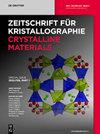1,4,8,11-四氮杂环十四烷(cyclam)在与环状配体环内外的金属离子形成Co2+、Ni2+、Cu2+和Zn2+化合物中的多功能性
IF 2.7
4区 材料科学
Q3 CRYSTALLOGRAPHY
Zeitschrift Fur Kristallographie-Crystalline Materials
Pub Date : 2023-07-01
DOI:10.1515/zkri-2023-0026
引用次数: 0
摘要
摘要本文报道了在各种金属配体比例和溶剂介质条件下,用环状配体1,4,8,11-四氮杂环十四烷[cyclam]制备金属化合物(其中金属离子为Co2+,Ni2+,Cu2+,Zn2+)的结果。在所有情况下,我们都按照规定使用金属Cl2·nH2O盐(无水CoCl2除外)。结果:我们在配体的N4腔中单独分离出具有四配位金属的物种,也分离出具有一个或两个额外轴向配体的物种。这些轴向配体可以是(a)单一的氯化物,导致五配位的二阳离子产物;(b) 两种氯化物,导致八面体中性化合物;(c) 两种水,产生六配位的[(cyclam)金属(H2O)2]2+物种。最后,在向反应介质中加入HCl的情况下,环糊精可以被二质子化,并在晶体中以[(环糊精)H2]2+的形式出现。对于如此多种的产物,由于金属配位数变化,因此环糊精配体的立体化学受到影响也就不足为奇了。有趣的是,[(cyclam)金属]物种总是以两种类型的无限串相互氢键:(1)晶体的Z′=1具有单串的那些;(2) 当Z′=2时,存在一对通过各种氢键相互连接的同质链。最后,我们观察到了一对有趣的氢xonium阳离子:第一种是由位于[(cyclam)金属]部分片之间的融合五边形组成的褶皱2-D片中的氢oxonium阳离子;第二个是组成为{(H3O+)-(H2O)-(H3O+H2O)-。本文章由计算机程序翻译,如有差异,请以英文原文为准。
The versatility of 1,4,8,11-tetraazacyclotetradecane (cyclam) in the formation of compounds of Co2+, Ni2+, Cu2+, and Zn2+ with metal ions in and out of the cyclic ligand ring
Abstract Herein we report the results of preparing metal compounds (where the metal ions are Co2+, Ni2+, Cu2+, Zn2+) with the cyclic ligand 1,4,8,11-tetraazacyclotetradecane [cyclam] under a variety of conditions of metal-ligand ratios and solvent media. In all cases, we used metal Cl2·nH2O salts (except for anhydrous CoCl2), as specified. Outcome: we isolated species with a four-coordinate metal in the N4 cavity of the ligand alone, and also with either one or two additional axial ligands. Those axial ligands can be (a) a single chloride, leading to penta-coordinated moncationic products; (b) two chlorides, leading to octahedral-neutral compounds; (c) two waters, giving rise to hexa-coordinated [(cyclam)metal(H2O)2]2+ species. Finally, in the case of HCl added to the reaction medium, the cyclam can be di-protonated and appears as [(cyclam)H2]2+ in the crystals. With such a variety of products, it is not surprising that since the metal coordination numbers vary, the cyclam ligand stereochemistries are thereby affected. Interestingly, the [(cyclam)metal] species are invariably hydrogen-bonded to one another in infinite strings of two kinds: (1) those for which the crystal’s Z′ = 1 have single strings; (2) when Z′ = 2, there is a pair of homogeneous strings attached to one another by a variety of hydrogen-bonding linkages. Finally, we observed an interesting pair of hydroxonium cations: the first is hydoxonium cations in a pleated 2-D sheet consisting of fused pentagons located between sheets of [(cyclam)metal] moieties; the second one is an infinite string of composition {(H3O+)-(H2O)-(H3O+)-(H2O)-(H3O+)-(H2O)-(H3O+)}∞.
求助全文
通过发布文献求助,成功后即可免费获取论文全文。
去求助
来源期刊

Zeitschrift Fur Kristallographie-Crystalline Materials
CRYSTALLOGRAPHY-
CiteScore
2.00
自引率
16.70%
发文量
55
期刊介绍:
Zeitschrift für Kristallographie – Crystalline Materials was founded in 1877 by Paul von Groth and is today one of the world’s oldest scientific journals. It offers a place for researchers to present results of their theoretical experimental crystallographic studies. The journal presents significant results on structures and on properties of organic/inorganic substances with crystalline character, periodically ordered, modulated or quasicrystalline on static and dynamic phenomena applying the various methods of diffraction, spectroscopy and microscopy.
 求助内容:
求助内容: 应助结果提醒方式:
应助结果提醒方式:


